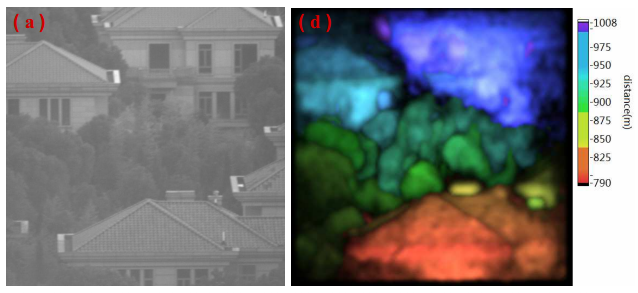First 3D ghost images from a single pixel
January 29, 2013

3D ghost imaging. Left: conventional telephoto image; right: 3D ghost image with distance (790 to 1008 meters) represented by color (credit: Wenlin Gong et al.)
Shanghai Institute of Optics and Fine Mechanics in China physicists have designed and built a remote-sensing “ghost imaging” device that uses a single pixel to record three-dimensional images, MIT Technology Review reports.
Ghost imaging is the extraordinary technique of bouncing a laser beam off an object and making high quality images from the reflected light using a single pixel. This single pixel is used to record data points over a series of time slices; the data is then stitched together to create the image.
There is no scanning involved. Instead, the data from the single pixel is compared against the intensity of the original laser beam, which must be randomized by passing it through frosted glass. Then any correlations between the original and reflected beam reveal information about the object in the image.
It is these correlations that physicists use to assemble the picture, known as a ghost image.
The amount of data required to create an image in this way is tiny compared to the amount that ordinary imaging requires. It is possible to record the equivalent of a 5 megapixel image using just 50,000 pixels.
Physicists have demonstrated this technique in various different ways since 1995 but it is only in the last few years that they’ve begun to understand it properly and started to exploit it.
The modification from previous ghost imaging systems is simple. They use short laser pulses of just 10 nanoseconds to briefly illuminate the object of interest and then turn on their single pixel for a short period of time so that it captures light reflected only from a specific distance.
This kind of gating produces image slices that can then be put together to create a three dimensional scene, a technique known as laser detection and ranging or LADAR.
The researchers use a green laser and a small telescope fitted with a single pixel to capture 3D images of ordinary objects about a kilometer away. The image above, for example, shows a group of houses and trees about 900 meters away and has a spatial resolution of 25cm and a depth resolution of 60 cm.
The technology would be useful for remote sensing applications, such as surveillance of distant objects.